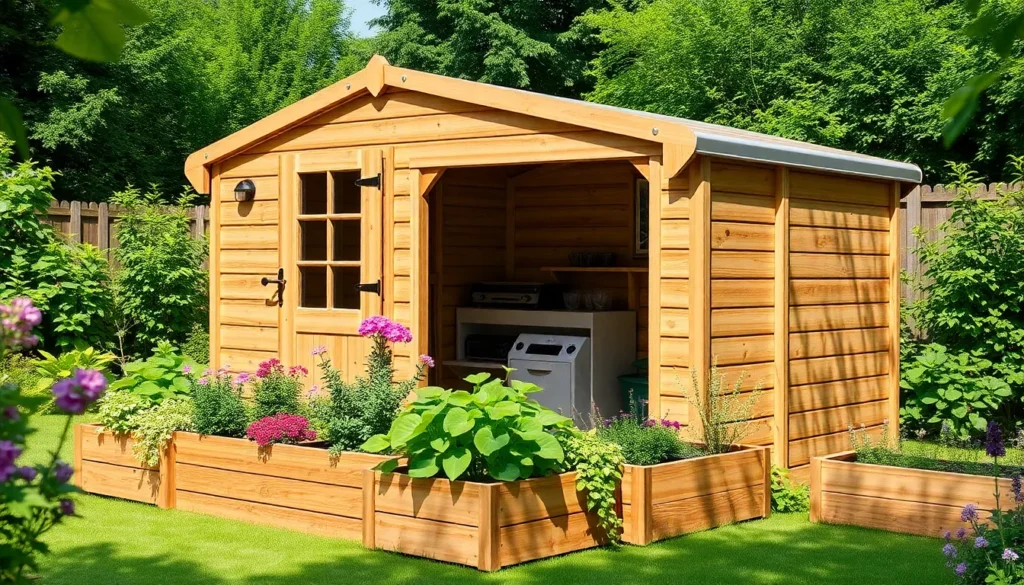In a world where plastic straws seem to have a vendetta against marine life, sustainable living solutions have never been more crucial. Picture this: a planet where your morning coffee doesn’t come with a side of guilt and your home is a sanctuary for both you and the environment. Sounds dreamy, right? It’s time to turn that dream into reality.
Table of Contents
ToggleUnderstanding Sustainable Living Solutions
Sustainable living solutions encompass practices that reduce environmental impact while enhancing quality of life. These solutions focus on daily habits, choices, and innovations that align with environmental stewardship.
Definition of Sustainable Living
Sustainable living involves minimizing resource consumption and waste generation. This lifestyle emphasizes practices that support ecological balance. Individuals engaging in sustainable living often prioritize renewable resources and eco-friendly products. Commitment to sustainable choices contributes to preserving ecosystems and improving overall well-being. Sustainable living isn’t solely about individual actions; communities can adopt practices that lead to collective benefits.
Importance of Sustainability
Sustainability holds immense importance for the planet’s future. Ecological challenges like climate change and pollution demand immediate attention. Adopting sustainable practices helps mitigate these environmental issues. Communities that embrace sustainability often experience improved public health and economic resilience. Furthermore, sustainable practices create long-term benefits for natural resources, ensuring future generations enjoy a balanced environment. Prioritizing sustainability fosters a culture of responsibility and awareness that influences positive change.
Key Principles of Sustainable Living

Sustainable living relies on foundational principles that guide individuals toward minimizing their environmental impact. These principles focus on resource efficiency, responsible consumption, and eco-friendly choices.
Reduce, Reuse, Recycle
Reduction of waste ranks as a primary goal for sustainable living. Prioritizing the purchase of durable goods greatly lowers the volume of waste produced. Reusing items, such as containers and fabric bags, further cuts down on the need for new materials. Recycling materials like glass, metal, and paper conserves resources and reduces landfill contributions. Embracing these practices promotes a circular economy where materials are continuously repurposed.
Energy Efficiency
Energy efficiency stands out as a crucial component of sustainable living. Utilizing energy-efficient appliances leads to lower energy consumption without sacrificing performance. Switching to LED lighting fosters significant savings on electricity bills and minimizes environmental impact. Investing in proper insulation helps maintain comfortable home temperatures, ultimately reducing reliance on heating and cooling systems. These strategies collectively contribute to a significant decrease in greenhouse gas emissions.
Sustainable Transportation
Sustainable transportation options support eco-friendly living. Opting for public transit reduces individual carbon footprints while easing urban congestion. Biking and walking serve as excellent alternatives for short distances, promoting physical health alongside environmental preservation. Carpooling encourages shared rides, leading to fewer vehicles on the road. Electric and hybrid vehicles also offer cleaner alternatives, producing fewer emissions compared to traditional combustion engines.
Practical Sustainable Living Solutions
Incorporating sustainable living solutions into daily life enhances well-being while minimizing environmental impact.
Eco-Friendly Home Practices
Implementing eco-friendly home practices optimizes energy and resource use. Utilizing energy-efficient appliances reduces energy consumption significantly. Switching to LED lighting lowers electricity bills while lasting longer than traditional bulbs. Insulating homes effectively decreases heating and cooling costs. Furthermore, using non-toxic cleaning products enhances indoor air quality. Composting organic waste enriches soil, reduces landfill waste, and supports local gardens. Adopting these practices fosters a more sustainable and comfortable living environment.
Sustainable Food Choices
Making sustainable food choices impacts both health and the environment positively. Prioritizing local produce supports community farmers and reduces transportation emissions. Choosing organic items minimizes pesticide use and promotes biodiversity. Reducing meat consumption lowers greenhouse gas emissions associated with livestock farming. Buying in bulk diminishes packaging waste and encourages mindful purchasing. Preparing meals at home showcases creativity while minimizing reliance on processed foods. These conscious decisions contribute to a healthier planet and lifestyle.
Water Conservation Techniques
Employing water conservation techniques preserves this vital resource effectively. Installing low-flow fixtures decreases water usage without sacrificing comfort. Collecting rainwater for outdoor use reduces reliance on municipal supplies. Watering gardens early in the morning cuts evaporation losses. Opting for drought-resistant plants minimizes watering needs and promotes local wildlife. Fixing leaks promptly saves gallons of water daily, further promoting sustainability. Implementing these strategies fosters a responsible approach to water management and helps protect ecosystems.
Community and Global Impact
Sustainable living solutions shape both local communities and the global landscape. Efforts at various levels foster significant change and awareness around environmental practices.
Local Initiatives and Organizations
Local initiatives play a crucial role in promoting sustainable practices. Nonprofit organizations often lead community-driven efforts to reduce waste and promote eco-friendly solutions. Programs like community gardens engage residents while providing fresh, local produce. Workshops on composting and recycling educate participants about responsible disposal methods. Such organizations frequently collaborate with local businesses to encourage ethical practices and support green technology. In many towns, active community members form sustainability committees, working together to create awareness campaigns that inspire individual actions toward a greener future.
Global Trends in Sustainability
Global trends indicate a strong shift toward sustainability across various sectors. Governments worldwide increasingly adopt policies aimed at reducing carbon footprints and promoting renewable energy sources. International collaborations focus on meeting sustainable development goals, emphasizing clean energy, responsible consumption, and climate action. The rise of sustainable fashion highlights the need for ethical sourcing and production practices. Global corporations also embrace eco-friendly packaging to minimize plastic waste. Innovative technologies, such as electric vehicles and solar energy systems, gain momentum, reflecting a growing commitment to environmental stewardship on a worldwide scale.
Embracing sustainable living solutions is essential for creating a healthier planet and improving quality of life. By adopting eco-friendly practices and making conscious choices, individuals can contribute to a brighter future. Every small action counts whether it’s reducing waste, conserving energy, or supporting local initiatives.
Communities can thrive when they prioritize sustainability, fostering collaboration and awareness. On a global scale, the shift towards eco-friendly policies and practices signals a collective commitment to a sustainable future.
Ultimately, the journey towards sustainability is a shared responsibility that requires dedication and action from everyone. Together, they can pave the way for a greener world.










